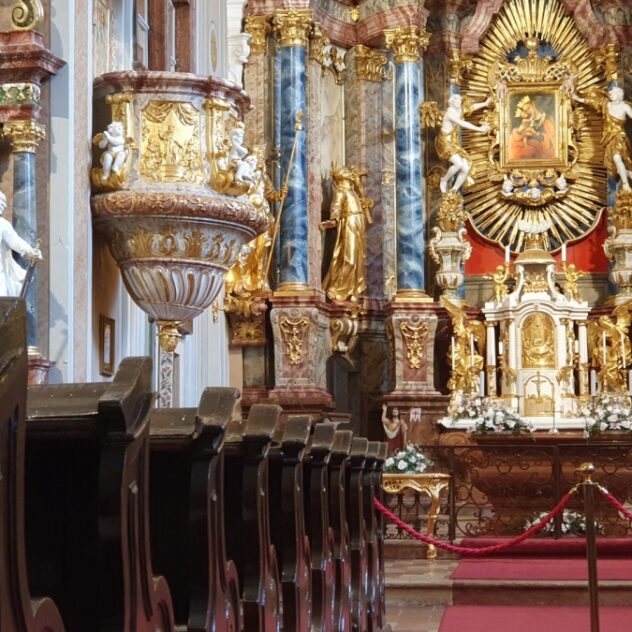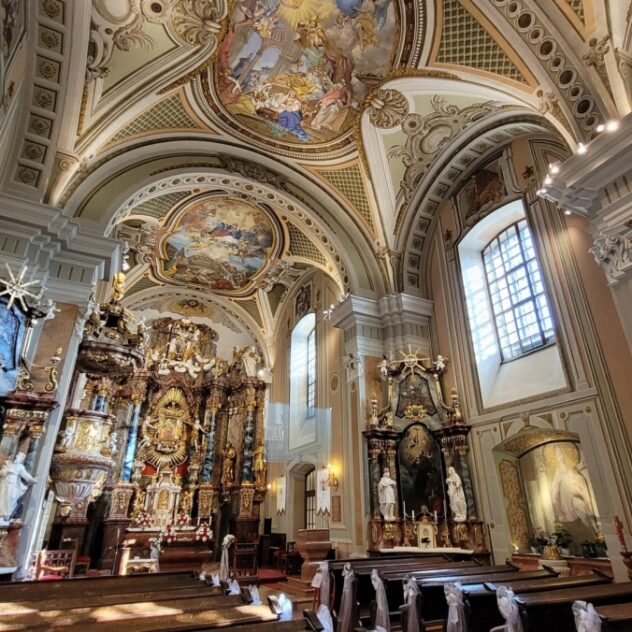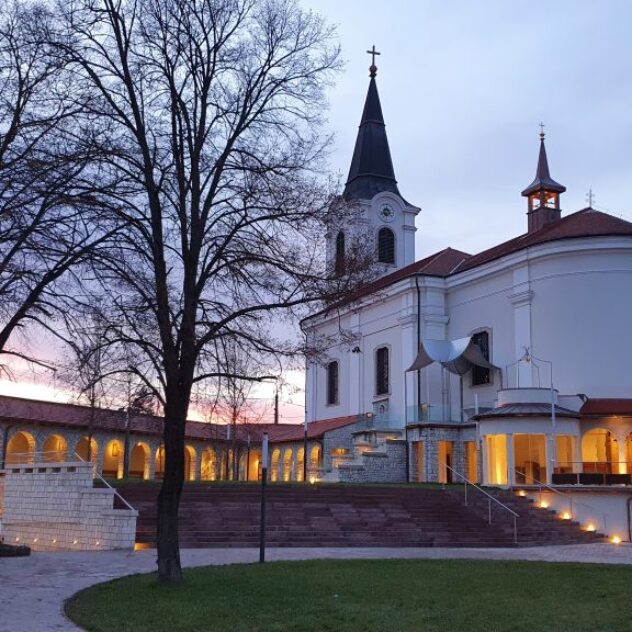Bodajki Segítő Szűz Mária-kegytemplom
Information about the pilgrimage site
Bodajk is located near the Móri-árok in Fejér County. The place was already a favored settlement area in prehistoric times due to its karst springs. According to local tradition, even King Stephen I, the founder of the Hungarian state, often visited the Bodajk pilgrimage site.
The first written mention of Bodajk dates back to 1193 in a charter issued by King Béla III, where the name appears as “Bosogth.” The first and only written record of the local parish dates back to 1434. In 1695, the Mórra family invited Capuchin friars to settle in the village and brought in German settlers. The Capuchins received the rights of the Bodajk parish from the Bishop of Veszprém. The friars took notice of the area’s unique natural features, about which they made detailed descriptions. The ruins of a chapel found in the village also caught their attention. According to local residents, this chapel was built in honor of the Virgin Mary during the time of the foundation of the state, and it was often visited by King Stephen I. Father Willibald Steyri, the head of the Capuchins in Mór, advocated for the establishment of the Bodajk Marian pilgrimage site. The efforts of the Capuchins contributed to the Catholicization of the locals and the integration of the settlers. Willibald Steyri commissioned an altarpiece depicting the Virgin Mary to be made in Vienna. The chapel was completed two years later, in 1697, and became a well-known pilgrimage site, leading to the idea of expanding the chapel.On September 30, 1742, Bishop Zsigmond Berényi of Pécs consecrated the new, still-standing church, built by Pál Häzinger. The interior decoration of the church was completed in 1786.
In 1788, the friars had to leave the monastery because Emperor Joseph II abolished the Capuchin order. Since then, the tasks have been taken over by the Diocese of Székesfehérvár. In the 1930s, expansion of the pilgrimage site began due to increased pilgrimages and devotions, initiated by Lajos Shvoy. Cardinal József Mindszenty blessed the newly completed pilgrimage site in 1948.
From 2016, further renovations began, aiming to transport visitors back to the past while providing modern amenities. Next to the Parish Office, there is a permanent exhibition about the history of the pilgrimage site.
The Bodajk Marian icon is located on the altar of the Bodajk parish church. Countess Colloredo donated the icon. Initially, the Countess did not want to help, claiming she had already done enough for the friars. However, after the Virgin Mary appeared to her in a dream and afflicted her with illness for not helping Father Willibald, the Countess ordered the icon, and upon its completion, she was healed. The miracles began with the Countess’s recovery. Miracles experienced at the pilgrimage site have been recorded since 1729, including healings and answered prayers. Grateful believers placed silver or gold ex-votos near the icon, symbolizing different body parts like the heart, feet, or hands. Many of the most valuable items can still be seen today. The silver chain hanging around the Virgin Mary’s neck is also an ex-voto, which still adorns the icon in its original form.
Tourist attractions in the vicinity
Székesfehérvár – the city of kings is only a 25-minute drive from Bodajk. With significant historical importance, the city offers numerous attractions to visitors. The Ruins of the Coronation Basilica is a National Memorial Site where 38 Hungarian kings were crowned, and 14 Hungarian kings were buried with their family members. The Bory Castle is an unmissable destination in the city. The castle’s walls are covered with paintings, mosaics, and stained glass windows throughout. The castle features seven towers and thirty rooms, all filled with sculptures, artworks, paintings, and antiques. In the downtown area of Székesfehérvár, it’s recommended to visit the Crowned Apple, the City Hall Square, and the Flower Clock.
Bakonynána – the waterfall of the Roman Baths is perfect for hiking and excursions along the banks of the Gaja Stream. In the valley, numerous resting and picnic areas await visitors. Nearby, you can also find the Savanyú Jóska Cave and the Vadalmás Spring.
Fehérvárcsurgó – Károlyi Castle – the castle was built in 1844 in neoclassical style by the Károlyi family. The castle operates as a museum, showcasing the life of the Károlyi family and Hungarian aristocracy. The castle is surrounded by a castle park and arboretum, where visitors can explore a 100-170 year old indigenous and exotic tree population. There is also a charming boating lake in the castle park.
Csókakő – castle was built into the side of Csókakő Hill at an altitude of 479 meters. The first written document mentioning the castle dates back to 1299. In 2014, the castle was almost completely rebuilt.
Gánt Bauxite Geological Park – a 13-station educational trail awaits visitors here. The trail, spanning 3.5 km, provides information about the geological features of the area through informative signs. At the Balás Jenő Bauxite Mining Museum, visitors can learn about the heyday of mining in Hungary.
Other tourists attractions in the vicinity of the pilgrimage site can be found on the szekesfehervar offical tourism website: https://turizmus.szekesfehervar.hu/catalog/index/43/lang/en
Accommodation
– Accommodation for pilgrims: The Szent Imre Pilgrim House is located just 50 meters from the sanctuary (https://www.bodajkikegyhely.hu/?page_id=71).
– Other private accommodation in the vicinity of the pilgrimage site.
Availability
By car
It takes approximately 1 hour and 5 minutes to travel from Budapest to Bodajk by car via the M7 motorway and the M81 expressway. Bodajk is located 23 km away from Székesfehérvár on route 81. Bodajk is only 10 km away from Mór along route 81.
By public transport
It takes about 1 hour and 45 minutes to travel from Budapest to Bodajk by train with a transfer in Székesfehérvár. The journey by bus from Székesfehérvár to Bodajk takes 35 minutes.
On foot
The section of road connecting Mór and Bodajk is considered a pilgrimage route.
On a bicycle
Mór and Bodajk are connected by a 3.8 km long bicycle path.








